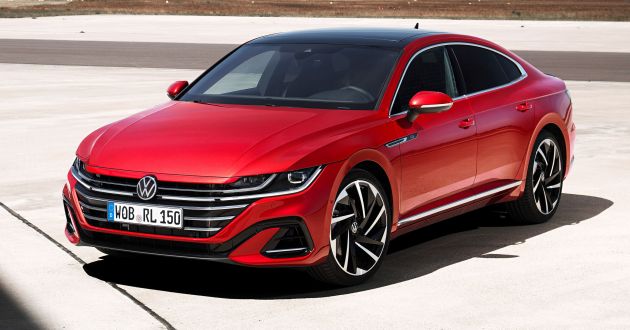2020 Volkswagen Arteon facelift debuts – new PHEV and 320 PS R variants, Shooting Brake model added
At long last, Volkswagen has finally revealed the newly facelifted Arteon, with the mid-cycle refresh coming a little over three years since the spiritual successor to the CC made its global debut. There’s plenty that’s new here, from styling changes to the introduction of a new body style and even a high-performance R version, so let’s dive right in.
First up, the Arteon will be available in a new Shooting Brake model, which is essentially a wagon body style that joins the existing fastback. With its elongated roof, the wagon does offer a bit more practicality in terms of cargo capacity when compared to the fastback, although it isn’t by much.
Volkswagen says with the second-row bench in its default position, the Shooting Brake offers 565 litres of cargo capacity (fastback: 563 litres) and up to 1,632 litres when the rear seats are folded down (fastback: 1,557 litres). In both cases, the load space has a maximum length of 2,090 mm, which is plenty for most items and even small furniture.
Styling-wise, the Shooting Brake doesn’t differ heavily from the regular fastback, with the main exception being its roof, as the two model share a similar look on either ends. Exterior updates that come with the facelift include a tweaked front fascia that features a new light strip that visually connects the headlamps (available with IQ.Light matrix LED tech), along with revised taillights at the rear.
With the Elegance trim level, the front apron now comes with angular corner “inlets” that sees the end of the full-width lower intake previously. Meanwhile, the R-Line adds on a more aggressive front bumper with the corner intakes accentuated by body-coloured “blades.”
At the rear, both trim levels are fitted with two large, trapezoidal-shaped exhaust “outlets,” although the R-Line takes things a step further by further subdividing them into four sections instead.
Moving inside, the Arteon’s dashboard layout has been heavily updated, with the most noticeable change being the air vents that are no longer integrated into a triple-slat trim piece that stretches end to end.
Instead, the angular vents are now clearly marked out in contrast to the new, more conventional trim piece, which also bids goodbye to the analogue clock. In other areas of the interior, there is now touch-based HVAC controls below the eight-inch infotainment screen for a more modern look, plus a new steering wheel design (also with touch controls) ahead of the 10.25-inch digital instrument cluster.
The German carmaker also points out the new MIB3 infotainment system supports wireless Android Auto and Apple CarPlay, as well as a 30-colour ambient lighting system, a wireless phone charger and a 700-watt Harman Kardon premium audio system.
Technology improvements include Travel Assist that allows for partly automated driving within a speed range from zero to 210 km/h. Additionally, the rearview camera gains a new corner view function which expands the camera image on the infotainment display from 90 degrees to 170 degrees and adds on a special trailer view.
When it comes to engines, the big news is the addition of a new, full-fat R variant for both the fastback and Shooting Brake. This is the range-topper in the Arteon line-up, and it comes with an EA288 2.0 litre turbocharged four-cylinder engine that develops 320 PS (316 hp) and 420 Nm of torque.
A seven-speed dual-clutch DSG gearbox handles power deliver to all four wheels through an all-wheel drive system, which debuts a new piece of tech that Volkswagen calls R-Performance Torque Vectroing that varies the torque split between the front- and rear-axles as well as between the two rear wheels.



The Arteon R also comes with adaptive dampers and sits 20 mm lower than the standard car, complemented by beefier brakes. The look is also unique to the variant, with large, functional inlets at the front flanking a largely blacked-out centre intake. It also gets a subtle rear diffuser and four individual exhaust pipes at the rear.
If efficiency is the name of your game, there’s also an eHybrid plug-in hybrid variant that takes the powertrain from the Passat GTE. This consists of a 1.4 litre four-cylinder TSI engine (156 PS or 154 hp) and an electric motor (115 PS or 113 hp), with drive going to the front wheels via a DQ400 six-speed wet dual-clutch automatic gearbox.
Combined, the total system output is 218 PS and it offers up to 53 km when running on pure electricity from the 13-kWh battery, during which you are also limited to top speed of 140 km/h. The carmaker didn’t provide charging details, but with the Passat GTE, there’s an onboard 3.6 kW battery charger that takes four hours to fully recharged the battery with a dedicated wall box/charging station rated at 360 V/3.6 kW.
Depending on markets, the Arteon can be had with a mix of 1.5 and 2.0 litre four-cylinder petrol engines and a 2.0 litre turbodiesel, which can be paired with 4Motion all-wheel drive – most transmissions are mostly DSG units.










2020 Volkswagen Arteon eHybrid Elegance 








2020 Volkswagen Arteon Shooting Brake R 


















2020 Volkswagen Arteon Shooting Brake eHybrid R-Line 













2020 Volkswagen Arteon Elegance 






































The post 2020 Volkswagen Arteon facelift debuts – new PHEV and 320 PS R variants, Shooting Brake model added appeared first on Paul Tan's Automotive News.
from Paul Tan's Automotive News
Read The Rest:paultan...

























































Post a Comment